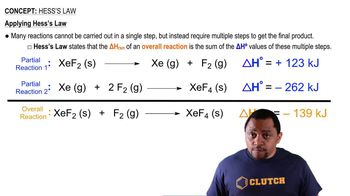The discovery of hafnium, element number 72, provided a controversial episode in chemistry. G. Urbain, a French chemist, claimed in 1911 to have isolated an element number 72 from a sample of rare earth (elements 58–71) compounds. However, Niels Bohr believed that hafnium was more likely to be found along with zirconium than with the rare earths. D. Coster and G. von Hevesy, working in Bohr's laboratory in Copenhagen, showed in 1922 that element 72 was present in a sample of Norwegian zircon, an ore of zirconium. (The name hafnium comes from the Latin name for Copenhagen, Hafnia). (a) How would you use electron configuration arguments to justify Bohr's prediction?
(c) Consider the metal oxides whose enthalpies of formation (in kJ mol⁻¹) are listed here: Oxide K₂O₍s₂₎, CaO₍s₂₎, TiO₂₍s₂₎, V₂O₅₍s₂₎, ΔHf° -363.2, -635.1, -938.7, -1550.6. Calculate the enthalpy changes in the following general reaction for each case: MnOm₍s₂₎ + H₂(g) → nM₍s₂₎ + mH₂O(g). (You will need to write the balanced equation for each case and then compute ΔH°.)
 Verified step by step guidance
Verified step by step guidanceKey Concepts
Enthalpy of Formation (ΔHf°)

Balanced Chemical Equation

Hess's Law

The discovery of hafnium, element number 72, provided a controversial episode in chemistry. G. Urbain, a French chemist, claimed in 1911 to have isolated an element number 72 from a sample of rare earth (elements 58–71) compounds. However, Niels Bohr believed that hafnium was more likely to be found along with zirconium than with the rare earths. D. Coster and G. von Hevesy, working in Bohr's laboratory in Copenhagen, showed in 1922 that element 72 was present in a sample of Norwegian zircon, an ore of zirconium. (The name hafnium comes from the Latin name for Copenhagen, Hafnia). (d) Using their electron configurations, account for the fact that Zr and Hf form chlorides MCl4 and oxides MO2.
The discovery of hafnium, element number 72, provided a controversial episode in chemistry. G. Urbain, a French chemist, claimed in 1911 to have isolated an element number 72 from a sample of rare earth (elements 58–71) compounds. However, Niels Bohr believed that hafnium was more likely to be found along with zirconium than with the rare earths. D. Coster and G. von Hevesy, working in Bohr’s laboratory in Copenhagen, showed in 1922 that element 72 was present in a sample of Norwegian zircon, an ore of zirconium. (The name hafnium comes from the Latin name for Copenhagen, Hafnia). (c) Solid zirconium dioxide, ZrO2, reacts with chlorine gas in the presence of carbon. Starting with a 55.4-g sample of ZrO2, calculate the mass of ZrCl4 formed, assuming that ZrO2 is the limiting reagent and assuming 100% yield.
The first 25 years of the twentieth century were momentous for the rapid pace of change in scientists' understanding of the nature of matter. (b) In what ways is de Broglie's hypothesis, as it applies to electrons, consistent with J. J. Thomson's conclusion that the electron has mass? In what sense is it consistent with proposals preceding Thomson's work that the cathode rays are a wave phenomenon?
The two most common isotopes of uranium are 235U and 238U. (b) Using the periodic table in the frontinside cover, write the electron configuration for a U atom.
